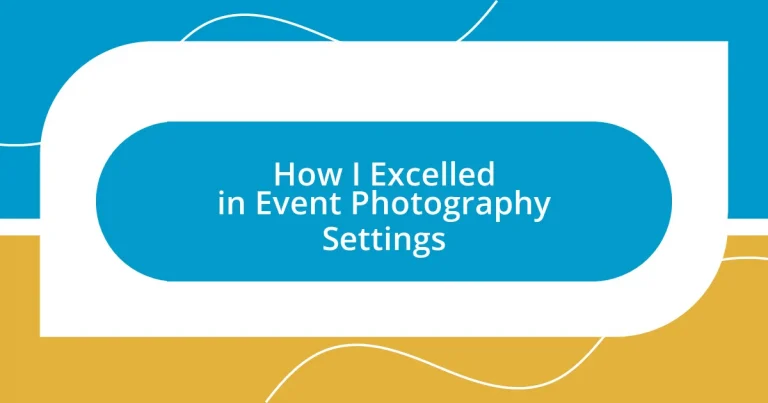Key takeaways:
- Mastering lighting and camera settings is crucial for capturing the essence of events, with techniques like wide aperture and quick shutter speed enhancing image quality.
- Building rapport with clients through empathy and genuine connections allows for more authentic photography, leading to repeat business and meaningful relationships.
- Post-processing techniques, such as color grading and strategic cropping, can transform images, improving their emotional impact and storytelling ability.
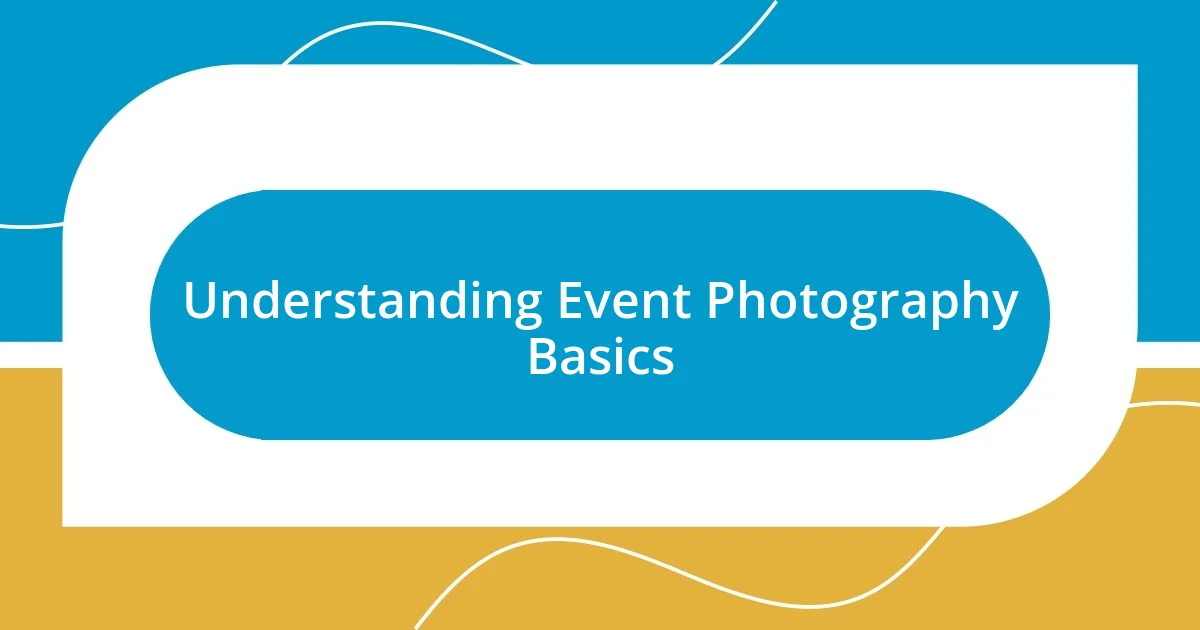
Understanding Event Photography Basics
Event photography is all about capturing moments as they unfold, and understanding the basics is essential. When I first started, I remember feeling overwhelmed by the fast pace of events. Have you ever rushed to catch a fleeting smile or an unexpected burst of laughter? It’s exhilarating and challenging all at once.
Lighting plays a crucial role in how your images turn out. There’s something magical about natural light, but I learned quickly that indoor events often require a different approach. During one wedding, I struggled with dim lighting but found that using a bounce flash could brighten the scene without losing that warm, candid feel. I’ll never forget the joy on the couple’s faces when they saw those beautifully lit moments come to life.
Then there’s composition, which is more than just framing your shot correctly. It’s about telling a story through your images. I often ask myself, “What feelings do I want to express in this scene?” This reflective thinking has shaped my shooting style. For instance, during a charity gala, I focused on the small details—like a child’s hand resting on an adult’s shoulder—which spoke volumes about connection and compassion. This is the essence I strive to capture; it transforms ordinary moments into enduring memories.
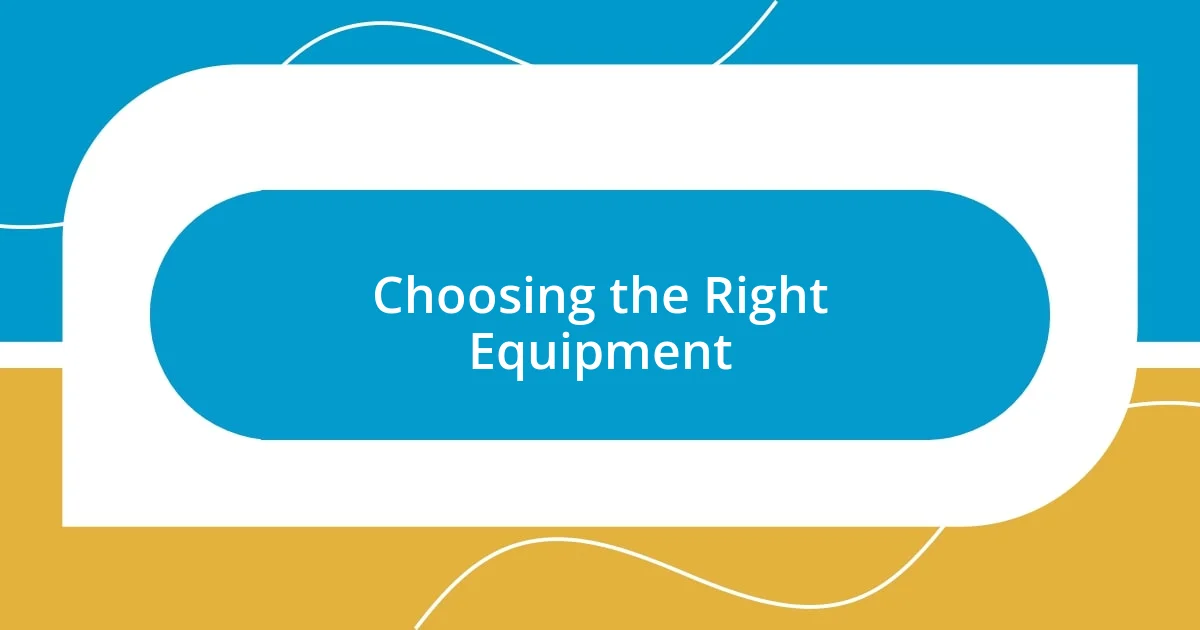
Choosing the Right Equipment
Choosing the right equipment can make or break your event photography experience. I vividly recall a time at a bustling corporate event where my lens faltered just when I needed to capture a vital speech. I had opted for a standard kit lens instead of my favorite prime lens, and in that moment, I deeply regretted it. Your gear should be reliable and match the environment in which you’re shooting.
While it’s tempting to invest in flashy accessories, I’ve found that focusing on versatile pieces pays off. For example, a good zoom lens allows for quick adjustments without missing those intimate moments across the room. During a recent birthday celebration, being able to zoom in on the cake-cutting ceremony from a distance made all the difference. Remember, it’s not just about the equipment but knowing how to use it effectively.
Lastly, consider your support gear. A sturdy tripod or a comfortable strap can enhance your experience immensely. There have been events where I spent too much time worrying about shaky shots instead of enjoying the festivities simply because I didn’t use my tripod. Your equipment should give you a sense of security, enabling you to immerse in the event while capturing its essence.
| Equipment Type | Example |
|---|---|
| Camera | DSLR vs Mirrorless |
| Lens | Zoom vs Prime |
| Support Gear | Tripod vs Handheld |
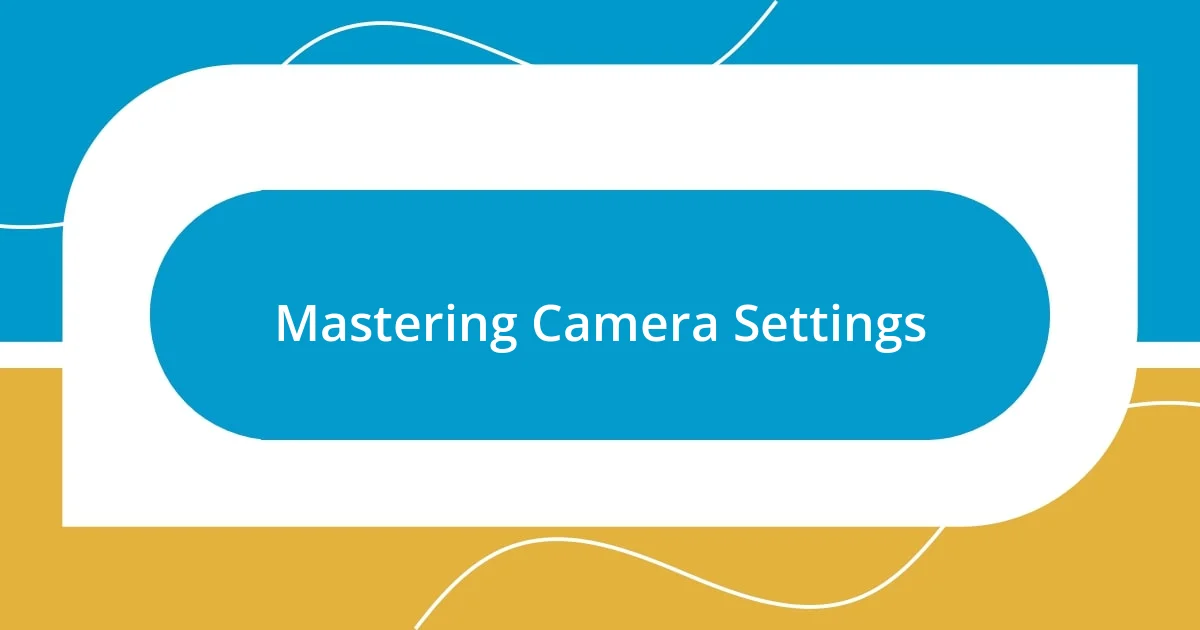
Mastering Camera Settings
Mastering camera settings is pivotal in capturing those spontaneous moments at events. I remember a lively wedding where I was wrestling with the exposure settings, trying to get that perfect balance between the twinkling fairy lights and the emotions on the dance floor. After several attempts, I found that setting my aperture wide open allowed me to let in more light while beautifully blurring the background. The result? Images where every joyful expression stood out vibrantly against a dreamy backdrop.
Here are some crucial camera settings I focus on:
- Aperture: A wide aperture (like f/1.8) for depth of field, drawing attention to the subject.
- Shutter Speed: A quick shutter speed (1/250 or faster) to freeze motion, especially during dances or energetic speeches.
- ISO: Adjusting ISO (800 or higher in low light) to maintain image quality while removing graininess.
- White Balance: Setting it according to the lighting—daylight, tungsten, or auto can drastically change the mood.
By mastering these settings, I found I could capture the essence of each event without being bogged down by technical issues. Each time I fine-tune them, I feel more confident and connected to the moments I’m freezing in time.
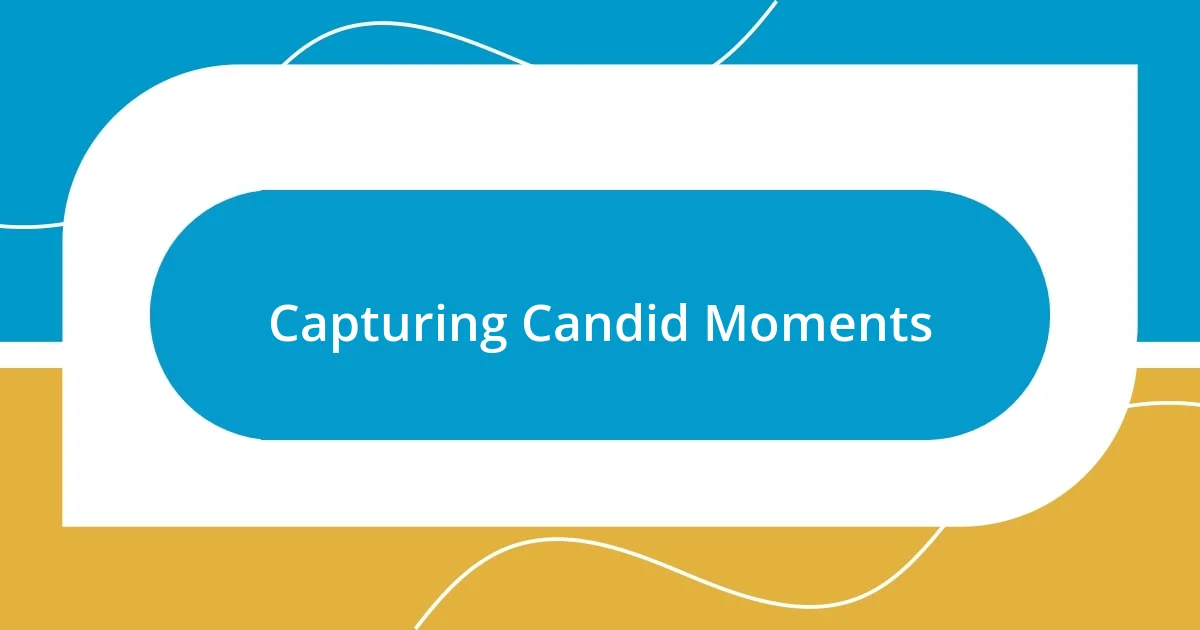
Capturing Candid Moments
Capturing candid moments is truly one of the most rewarding aspects of event photography. I often think about a vibrant family reunion where the laughter and stories flowed freely. While everyone was busy mingling, I found myself hidden in a corner, watching a little girl break into a joyful dance. Those moments—raw and unplanned—bring life to the images. It’s a thrill to hit the shutter at just the right second, freezing that infectious joy forever.
The key to capturing those unguarded interactions is to be an unobtrusive presence in the crowd. I recall a particularly bustling festival where I opted to blend in among the guests rather than standing out with my camera. This choice allowed me to capture genuine expressions—friends catching up, couples sneaking kisses, and spontaneous bursts of laughter. Is there anything more heartwarming than a candid shot that tells a story? It’s those images that often resonate the most with viewers because they reveal the essence of the moment, unfiltered and full of emotion.
Timing and patience also play crucial roles in this process. At a recent wedding, I found myself sitting quietly at a table when the bride and her father shared a sweet whisper before the first dance. I hesitated for a moment, debating whether to grab the shot or let that intimate moment pass. Ultimately, I couldn’t resist, and those few frames turned into some of my favorite images from the event. It’s in those quietly observed instances where the magic of event photography truly happens—from laughter to tears, the authenticity shines through.
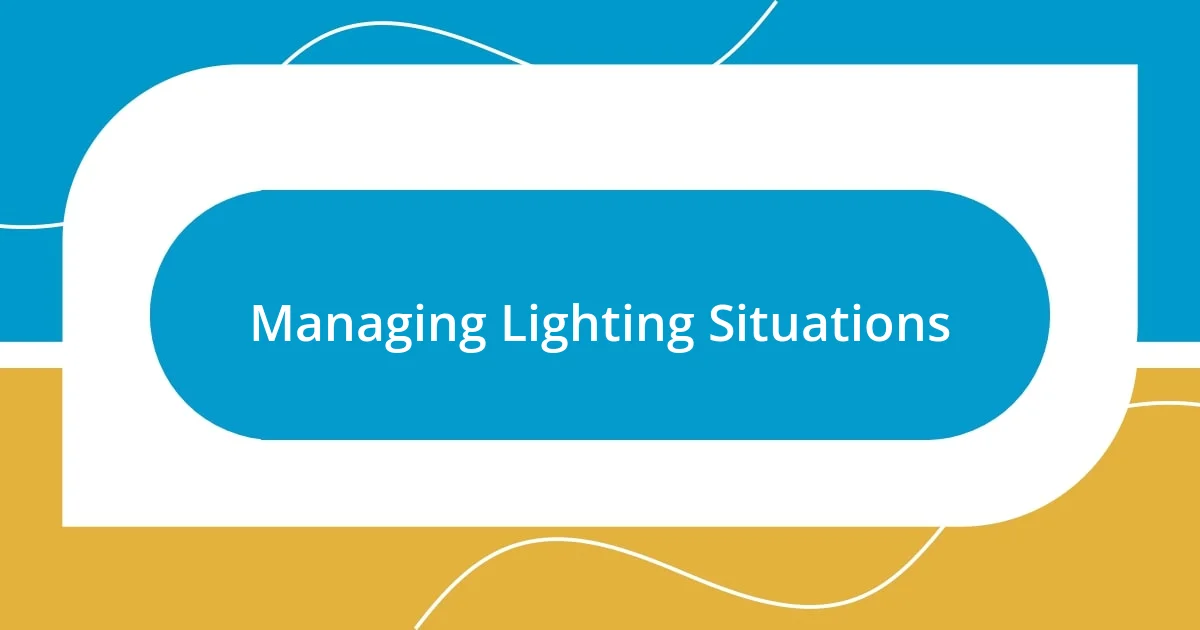
Managing Lighting Situations
Managing lighting situations can make or break your shots in event photography. I remember a particularly challenging outdoor wedding that extended into the evening. As the sun set, I found myself juggling between natural light and the newly installed string lights. To tackle the changing conditions, I adjusted my ISO to match the dimming light while also using a prime lens to help capture those soft glows. It was gratifying to see how those adjustments transformed the mood, creating an enchanting ambiance in my photos.
Sometimes, improvisation is key. At a fundraiser I shot, the venue had a mix of harsh overhead lights and shadows that created an uneven look in photos. Instead of relying solely on my camera settings, I moved around, using handheld reflectors to bounce light back onto the faces of the attendees. This small change made a huge difference, illuminating their smiles and expressions. Have you ever thought about how just a little adjustment can turn a good photo into a great one?
One essential tip I swear by is not to hesitate with creative lighting solutions. At a recent birthday bash, I encountered a brilliantly lit dessert table that was overshadowed by dim overhead lights. I didn’t have any external flashes with me, so I creatively used my phone’s flashlight and aimed it at the table while snapping my shot. The result? A beautifully lit scene that highlighted each vibrant dessert. It’s moments like these that remind me of the importance of thinking outside the box and how lighting can tell a story all on its own.
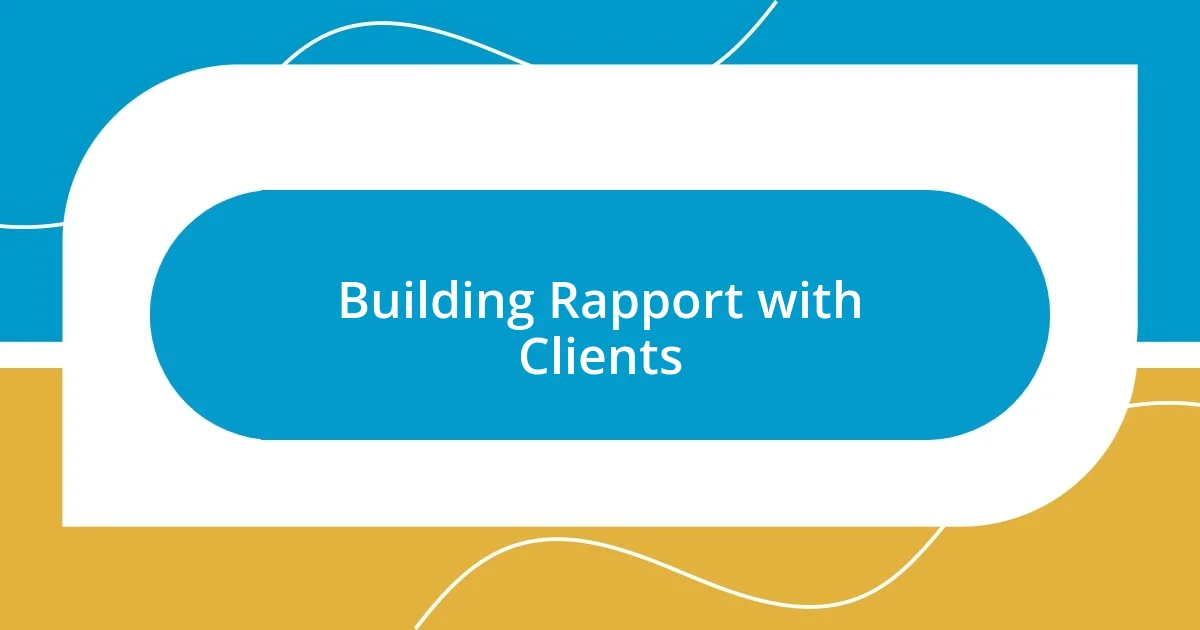
Building Rapport with Clients
Building rapport with clients is all about establishing a genuine connection. I vividly recall my first meeting with a couple who were nervous about having their wedding documented. I took a moment to share a bit of my journey in photography, weaving in some light-hearted stories to ease the tension. It was rewarding to see their smiles widen as we talked—suddenly, we weren’t just vendor and client; we were collaborators excited about their special day.
I find that empathy makes a world of difference. During one engagement session, I asked the couple what they loved most about each other. Watching their faces light up as they expressed their feelings revealed aspects of their relationship that I aimed to capture in my photos. Isn’t it fascinating how these moments can transform a simple shoot into something deeply personal and meaningful? It’s through sincere conversations and heartfelt questions that I’ve noticed my clients become more relaxed, which allows me to capture their authentic selves.
Every little insight shared helps to break down barriers. After a successful shoot, I often follow up with a handwritten note or a quick text expressing my gratitude for the opportunity to work with them. It’s the little gestures, like acknowledging anniversaries or simply checking in, that solidify our relationship. Isn’t it amazing how those small connections can lead to trust and, ultimately, repeat business? In my experience, when clients feel valued beyond just the photography, they become more than clients; they become friends who trust me to capture their most treasured moments.
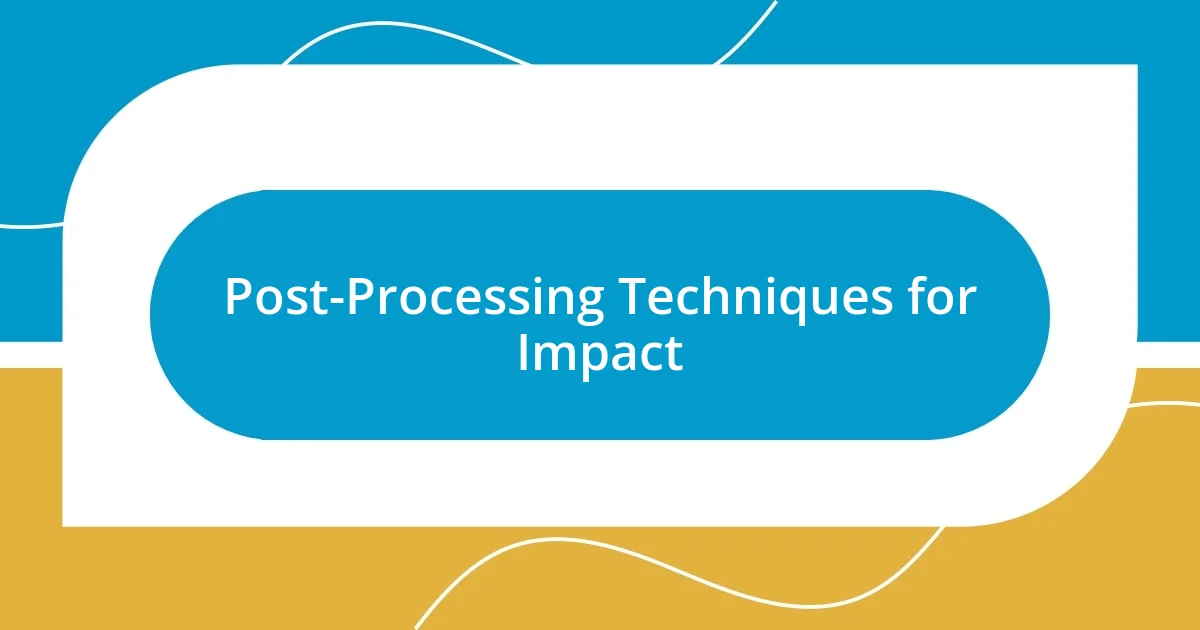
Post-Processing Techniques for Impact
Post-processing can truly elevate your event photography to new heights. I recall a corporate gala where the lighting was less than ideal, casting harsh shadows on the subjects’ faces. After the event, I dove into Adobe Lightroom, adjusting the shadows and contrast to soften those lines, all while maintaining the image’s integrity. The transformation was incredible; it felt like I had breathed new life into those images.
Color grading is another powerful technique that I’ve come to embrace. During one outdoor festival, the photos appeared a bit flat due to the overcast skies. In post-processing, I introduced a slightly warmer tone to evoke a sense of joy and festivity. It felt like I was painting a story onto the canvas, and that simple tweak made the photos pop with character. Have you ever noticed how color can completely change the mood of an image? It’s a game-changer.
Then there’s the art of cropping for composition. I once captured a candid moment at a wedding where a flower girl was twirling, but the background distracted from her joy. A quick crop helped focus the viewer’s attention squarely on her, enhancing the emotional impact of the shot. I always ask myself, how can I direct the viewer’s gaze to what truly matters? Learning to see these elements in post-processing has deepened my appreciation for the art form.












